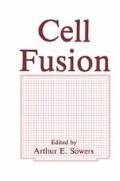Abstract
Until recently, virtually all investigations into the behavior of cell hybrids have employed genetic selection techniques, such as the hypoxanthine-aminopterin-thymidine (HAT) system (Littlefield, 1964), to isolate the cell fusion products. In this approach, one starts with two cell lines, one of which lacks enzyme A and the other of which lacks enzyme B. After fusing the two cell types together, they are placed in a specially designed culture medium in which only cells that have both enzymes are able to grow. Under these conditions, neither parental cell line is able to divide. However, since the cell line that lacks enzyme A has enzyme B and vice versa, fusion products between the two do contain both enzymes and the cell hybrids are able to multiply. Although systems based on this approach have been extremely useful, there are a variety of practical and theoretical problems associated with their use. Obviously, only special cell lines that lack the necessary enzymes can be used. Although in some cases this problem can be surmounted by mutagenizing and isolating cells carrying the required defect, this can only be done with immortal cell lines. The cultured life span of normal diploid cells (Hayflick, 1965) is limited, so that by the time mutant clones are isolated they are essentially senescent.
Access this chapter
Tax calculation will be finalised at checkout
Purchases are for personal use only
Preview
Unable to display preview. Download preview PDF.
References
Blau, H. M., Chin, C. P., and Webster, C., 1983, Cytoplasmic activation of human nuclear genes in stable heterocaryons, Cell 32:1171–1180.
Davidson, R. C., 1974, Control of expression of differentiated functions in somatic cell hybrids, in: Somatic Cell Hybridization (R. L. Davidson and F. de la Cruz, eds.), pp. 131–150, Raven Press, New York.
Eisenberg, C. R., and Migeon, B. R., 1979, Enrichment of human heterokaryons by ficoll gradient for complementation analysis of iduronate sulfatase deficiency, Somatic Cell Genet.5:1079–1089.
Hayflick, L., 1965, The limited in vitro lifetime of human diploid cell strains, Exp. Cell Res.37:614–636.
Hohman, L. K., and Shows, T. B., 1979, Complementation of genetic disease: A velocity sedimentation procedure for the enrichment of heterokaryons, Somat. Cell Genet.5:1013–1029.
Jongkind, J. F., and Verkerk, A., 1982, Nonselective isolation of fibroblast heterokaryons, hybrids, and cybrids by flow sorting, in: Techniques in Somatic Cell Genetics (J. Shay, ed.), pp. 81–100, Plenum Press, New York.
Keeler, P. M., Person, S., and Snipes, S., 1977, A fluorescent enhancement assay of cell fusion, J. Cell Sci.28:167–177.
Littlefield, J., 1964, Selection of hybrids from mating of fibroblasts in vitro and their presumed recombinants, Science 145:709–710.
Miller, R. A., and Ruddle, F. H., 1976, Pluripotent teratocarcinoma-thymus somatic cell hybrids, Cell 9:45–55.
Norwood, T. H., Zeigler, C. J., and Martin, G. M., 1976, Dimethyl sulfoxide enhances polyethylene glycol-mediated somatic cell fusion, Somat. Cell Genet.2:263–270.
Okada, C. y, and Rechsteiner, M., 1982, Introduction of macromolecules into cultured mammalian cells by osmotic lysis of pinocytic vesicles, Cell 29:33–41.
Ringertz, N. R., and Savage, R. E., 1976, Cell Hybrids, Academic Press, New York.
Steinman, R. M., Silver, J. M., and Cohn, Z. A., 1974, Pinocytosis in fibroblasts. Quantitative studies in vitro, J. Cell Biol.63:949–969.
Veomett, G., 1982, Techniques for enucleation of mammalian cells, in: Techniques in Somatic Cell Genetics (J. W. Shay, ed.), pp. 67–79, Plenum Press, New York.
Wright, W. E., 1973, Production of mass populations of anucleate cytoplasms, in: Methods in Cell BiologY., Vol. VII (D. M. Prescott, ed.), pp. 203–210, Academic Press, New York.
Wright, W. E., 1978, The isolation of heterokaryons and hybrids by a selective system using irreversible biochemical inhibitors, Exp. Cell Res.112:395–407.
Wright, W. E., 1982, The selection of heterokaryons and cell hybrids using the biochemical inhibitors iodoacetamide and diethylpyrocarbonate, in: Techniques in Somatic Cell Genetics (J. Shay, ed.), pp. 48–65, Plenum Press, New York.
Wright, W. E., 1984a, The induction of muscle genes in neural cells, J. Cell Biol.98:427–435.
Wright, W. E., 1986, The expression of differentiated functions in heterokaryons between skeletal myocytes, adrenal cells, fibroblasts and glial cells, Exp. Cell Res.151:55–69.
Wright, W. E., 1984C., Toxin-antitoxin selection for isolating somatic cell fusion products between any cell types, Proc. Natl Acad. Sci. U.S.A.81:7822–7826.
Author information
Authors and Affiliations
Editor information
Editors and Affiliations
Rights and permissions
Copyright information
© 1987 Springer Science+Business Media New York
About this chapter
Cite this chapter
Wright, W.E. (1987). Nongenetic Techniques for Isolating Fusion Products between Different Cell Types. In: Sowers, A.E. (eds) Cell Fusion. Springer, Boston, MA. https://doi.org/10.1007/978-1-4757-9598-1_26
Download citation
DOI: https://doi.org/10.1007/978-1-4757-9598-1_26
Publisher Name: Springer, Boston, MA
Print ISBN: 978-1-4757-9600-1
Online ISBN: 978-1-4757-9598-1
eBook Packages: Springer Book Archive

